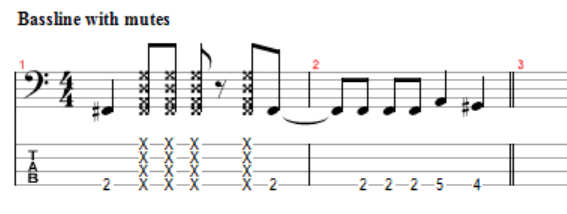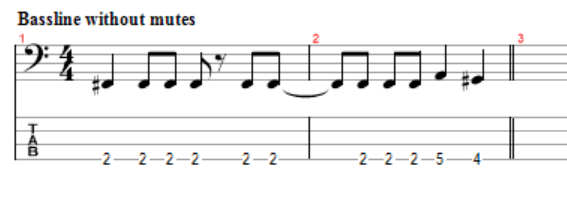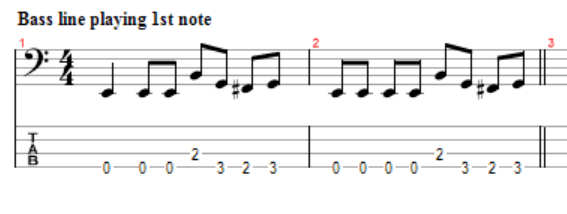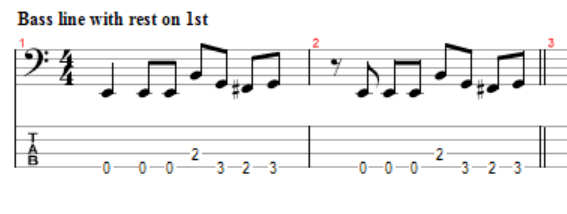Learning to play the bass alone is one thing, but how do you play bass with a band in a jam session?
Instead of just focusing on yourself you have multiple other people you have to pay attention to. In addition, you don`t have a pre-written song to go off and need to come up with everything on the spot.
When I started out as a bassist 14 years ago I remember jam sessions feeling intimidating because of this.
Luckily, I`ve come to learn that there is no pressure or mistakes to be made in a jam session. Unsurprisingly, once I understood this not only did jamming become more fun, I also got significantly better at it. I even picked up some uncommon tricks throughout the years that I`m going to be sharing.
So, here are 5 bass jamming tips that most of the bassists I’ve run into don’t utilize.
1. Add octaves and 5ths
Adding fifths and octaves is a beginner-friendly way to make your basslines more dynamic.
By adding them you will add a lot more flavor and identity to what you are playing. More importantly, fifths and octaves are a great way for you to get more in synch with your band members. If the guitarist is playing a riff or the drummer plays a groove with a clear accent, you can further add to it by accenting your line at the same time by adding a fifth.
Below is an example of a simple gallop line being played in three different ways. One with just root notes, one with fifths, and one with octaves.
The root note example sounds very simple; dun, du-du-dun, du-du-dun. While there is nothing wrong with this, the two other examples have a completely different feel to them, which your bandmates will pick up on.

This works great both if your band is having a dynamic jam, or if you have trouble moving it along. If the jam isn’t going anywhere you can start to introduce fifths and octaves to see how your bandmates respond. On the other hand, if there are a lot of good ideas going on, you can add to them with this technique where it feels appropriate.
It’s a simple trick, but it can make the difference between your jam sounding like 4 people playing at the same tempo or 4 people playing coherent music together.
2. Build slowly
Whether you prefer a simple groove or like to play shiny melodic lines, a jam works best when you build momentum slowly. Thus, you should always change your playing up gradually, and always listen to where your bandmates are looking to take the jam.
By taking the example of adding fifths and octaves above, this type of spice will always sound better when you introduce it throughout the jam. While showing all your cards immediately can give a great start to the jam, it will also make it harder to move the music along.
A great way to do this is to start by just holding sustained notes or playing root notes. This way you give your bandmates a lot of room to experiment with their own musical ideas.
If they come up with something great you can start adapting your bassline to fit their idea better. If they don’t come up with anything noteworthy, you can get more experimental with your bassline until they follow up on that instead. This is all about listening and adapting.
This works both if you are the one to play the first note, or if you follow up on what the drummer or guitar player is doing. The bass plays such an important role in the feel of a jam that you can create dynamic buildups almost completely on your own.
Naturally, your bandmates need to have an idea of how to create a buildup, but to a much lesser degree than one might think.
3. Add mutes
The most important member of the band to be in synch with when jamming as a bassist is the drummer.
As every drummer is different, you will produce more meaningful lines when you are able to adapt to their playing. Sometimes this will come naturally, other times it won’t.
One of my favorite ways to get in synch with a drummer is to play muted notes when starting out. This makes your playing more percussive and makes it easier to mimic what the drums are doing. Naturally, I will be playing notes too, but I will keep adding them on as I am getting a better feel for what the drummer is doing.
Muted strings can also serve to make your basslines groovier, and can be forgiving in a jam setting if you are struggling to play in the same key.
Many associate muted strings with slapping, but it can work equally well when playing with a pick. I mainly play with my fingers and strumming all 4 of my muted strings with my nails works wonders.
Here is an example of 2 basslines, one with muted strings and one without:


While they are essentially the same line, I find the first one to have a lot more groove to it. When playing with a drummer, its easier to start with a line like this to get into their rhythm.
4. Don’t always play on the first beat
One of the main roles of the bassist is to play the root note on the first hit of a beat. This is to establish the harmony of what chord is being played and to provide a low-end where it matters.
Thus, it would seem like a horrible idea to not be playing anything on the first beat of a bar, right?
Well, turns out that this can actually provide a lot of groove and lead to your rhythm section sounding more dynamic.
Below are two similar examples. One where the bass plays a regular bassline, and one where it drops the first note on the second beat.


This works especially well in a jam session, as it is a very noticeable cue that your bandmates can play off. Before you know it, resting on the first bar will have given your drummer and guitar player rhythmic ideas that will elevate your jam session.
Furthermore, you can do this anywhere in a jam. You don’t have to make it a repeating part of your bassline either. Thus, choosing to rest on the first note occasionally is a great way to breathe life into your jam.
5. Bring it back
In my experience, those unfamiliar with jams often have a romanticized idea of it, where all the members of a band are completely in sync. In reality, no band is this way. How good a band is at jamming depends on how talented the members of it are at taking cues from one another as the jam goes on.
With this in mind, it is the job of the bassists to bring the music back to a manageable state when it gets out of hand.
If the jam was based on a simple musical theme, I always revert back to playing that when the jam gets too chaotic. The core idea can be a simple riff, holding a sustained chord progression, or simply playing root notes. The core idea is generally the first thing played in a jam session.
It’s fine for a jam to go slow or get intense. The point of bringing it back is not to reduce the vigor of the jam, but rather to bring the band back on the same page when needed.
Conclusion
When people ask me how to jam on bass guitar, they tend to have this idea that there is a correct answer on how to do it.
While it is certainly an art form, this type of mindset is unconstructive when heading into band practice. The whole purpose of a jam is to give yourself and your band room to explore musical ideas in a pressureless environment.
With that said, these 5 tips will help you get an idea of how to start jamming as a bassist. If you are struggling to come up with ideas or make the jam move along, these are great to fall back on.
While playing bass alone is fun in its own right, nothing beats a good jam session with a band that is on the same page musically. At your next session make sure to incorporate at least one of the tips you read in this article; you will be surprised at the difference small changes can make.

